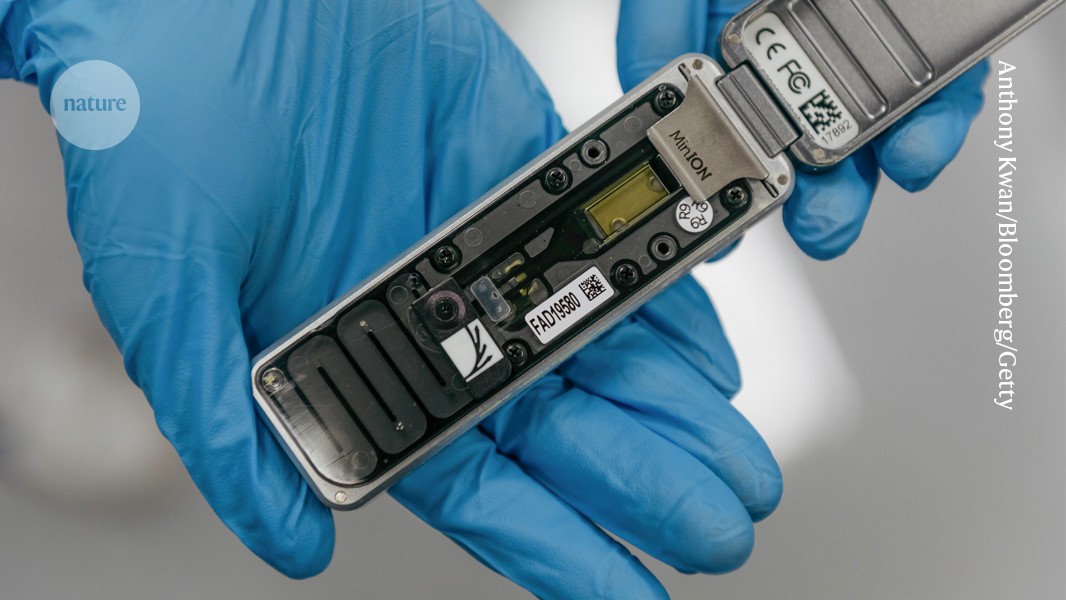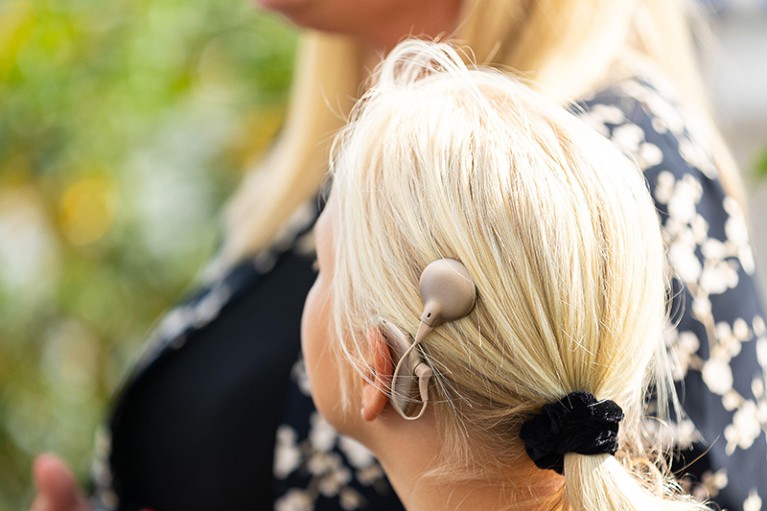Some people with cochlear implants can recognize speech within hours of the device being implanted, but for others it can take months or years.Credit: Michael Matthey/dpa/Alamy
Stimulating neurons that are linked to alertness helps rats with cochlear implants learn to quickly recognize tunes, researchers have found. The results suggest that activity in a brain region called the locus coeruleus (LC) improves hearing perception in deaf rodents. Researchers say the insights are important for understanding how the brain processes sound, but caution that the approach is a long way from helping people.
“It’s like we gave them a cup of coffee,” says Robert Froemke, an otolaryngologist at New York University School of Medicine and a co-author of the study, published in Nature on 21 December1.
Cochlear implants use electrodes in the inner-ear region called the cochlea, which is damaged in people who have severe or total hearing loss. The device converts acoustic sounds into electrical signals that stimulate the auditory nerve, and the brain learns to process these signals to make sense of the auditory world.
Inner-ear implants
Some people with cochlear implants learn to recognize speech within hours of the device being implanted, whereas others can take months or years. “This problem has been around since the dawn of cochlear implants, and it shows no signs of being resolved,” says Gerald Loeb at the University of Southern California in Los Angeles, who helped to develop the one of the first cochlear implants.
Researchers say that a person’s age, the duration of their hearing loss and the type of processor and electrodes in the implant don’t account for this variation, but suggest that the brain could be the source of the differences. “It’s sort of the black box,” says Daniel Polley, an otolaryngologist at Harvard Medical School in Boston, Massachusetts. Most previous research has focused on improving the cochlear device and the implantation procedure. Attempts to improve the brain’s ability to use the device opens up a way to improve communication between the ear and the brain, says Polley.
To explore this relationship, the research team trained 16 rats to respond to tunes1. On hearing a specific tune, the animals could poke their noses into a box to receive a treat. When they heard other tunes, the treat was not presented, and the rats learnt not to nose-poke.
The researchers then deafened the rats using surgery and placed a cochlear implant with eight electrodes, each encoding a tune, into the animals’ ears. The authors repeated the task but this time, when the researchers stimulated an electrode, the animal would hear the tune that was paired with a food reward.
Tune training
The authors reported that the rats all learnt to distinguish between the tunes that offered rewards and those that didn’t after 15 days. The researchers noticed that the activity of neurons in the LC increased when the animals responded correctly to the tunes and decreased when they were poking randomly and making errors.
Although the LC is not part of the auditory system, it supplies the system with the neurotransmitter noradrenaline, which boosts alertness; the LC also has a role in cognition, learning and memory, and attention. When the LC releases noradrenaline throughout the auditory system and the brain’s learning and attention circuits, this accelerates the learning and processing of auditory signals.
In another test, the authors stimulated the LC of one group of rats and didn’t in another group. The animals that were not stimulated took up to nine days to perform the task, whereas those with a stimulated LC learnt it in just three days. Froemke was surprised by how powerful the LC was in helping the animals to use the cochlear implants. “Every animal that got an implant learnt to do really well.”
Path to people
Researchers caution that stimulating the LC in humans could be dangerous. The region sends signals to many brain regions, and regulates the fight-or-flight response. Stimulating the LC in people “would raise blood pressure and heart rate, and [induce] other autonomic responses”, says Graeme Clark, an otolaryngologist in the Graeme Clark Institute at the University of Melbourne, Australia, who developed the first multi-channel cochlear implant in the 1970s. “We would have to do a series of experiments to prove that it is something worth doing.”
But there are other ways to engage brain circuits to work with the device, such as introducing neurotransmitters at the cochlear level, which is much safer, says Clark.
And in future, tools that use technologies to improve hearing perception might connect to a cochlear implant, which people could use to train themselves, says Froemke.








More News
Powerful ‘nanopore’ DNA sequencing method tackles proteins too
US funders to tighten oversight of controversial ‘gain-of-function’ research
Bird flu in US cows: where will it end?